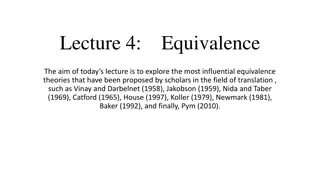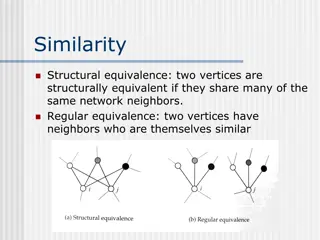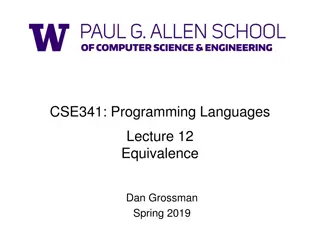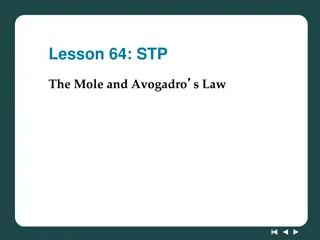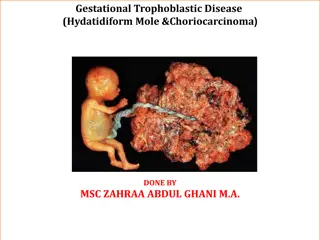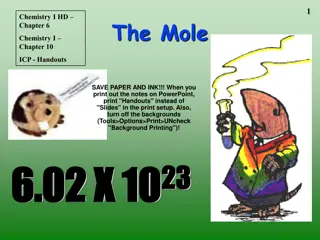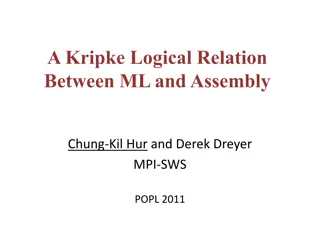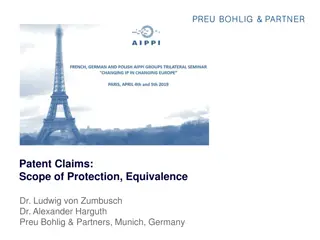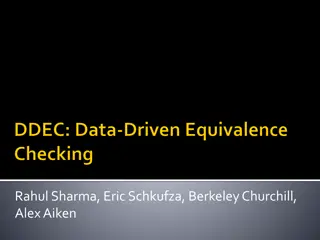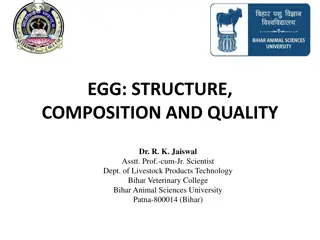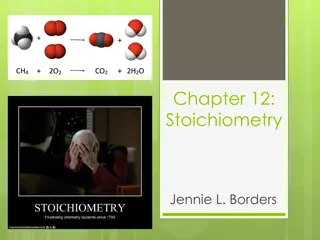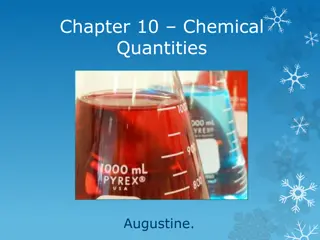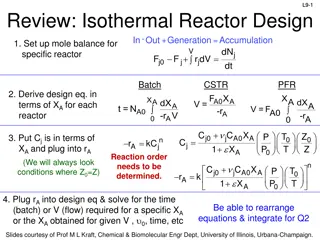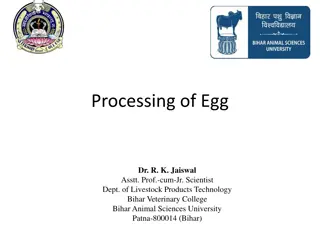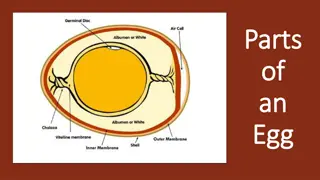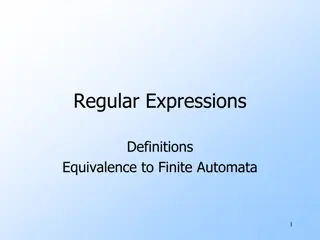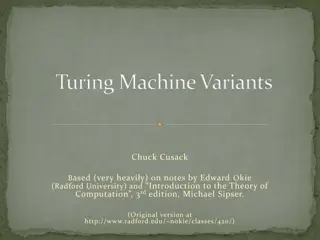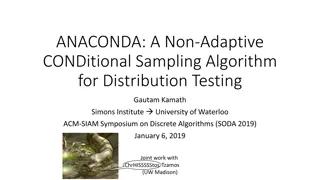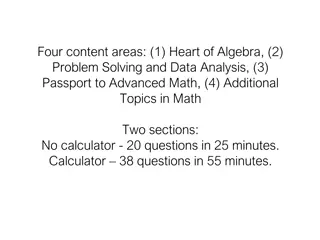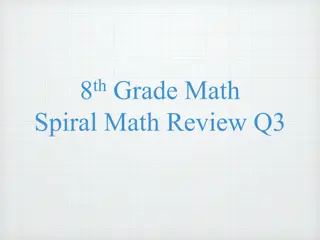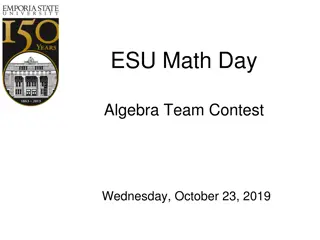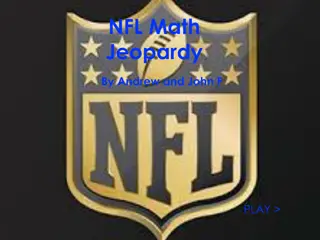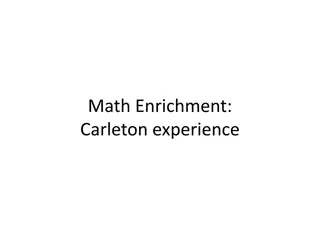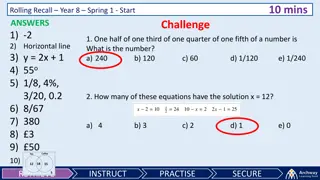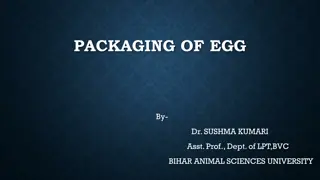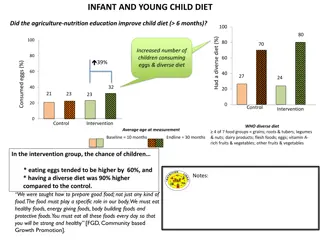The Equivalence of Egg Math and Mole Math
Explore the interesting comparison between egg math and mole math, where 1 egg is equivalent to one practical counting unit in the world of chemistry. Discover how a chemist's dozen relates to the Avogadro's number and molecular weight, highlighting the parallel between egg quantities and chemical elements.
Download Presentation

Please find below an Image/Link to download the presentation.
The content on the website is provided AS IS for your information and personal use only. It may not be sold, licensed, or shared on other websites without obtaining consent from the author. Download presentation by click this link. If you encounter any issues during the download, it is possible that the publisher has removed the file from their server.
E N D
Presentation Transcript
A seemingly silly digression : egg math exercise #1a dumb Doc questions: 12eggs/dozen A) A dozen large eggs is how many eggs? B)Mass of 1 dozen large eggs = 700 g/dozen* 1) What do 5 dozen large eggs weigh? 5 dozen * 700 g_ = 3500 g dozen 1 (one) dozen large eggs * According to Danny Wegman s site
More dumb Doc questions: egg math exercise #1b 12 A) 1 dozen eggs = B)Mass of 1 dozen large eggs = 700 g/dozen 2) How many dozens in 2800 g of large eggs ? 2,800 g * 1 dozen =4 dozen 700 g
More dumb Doc questions: egg math exercise #1c 12 A) 1 dozen eggs = B)Mass of 1 dozen large eggs = 700 g/dozen 3) How many eggs in 14,000 g of large eggs ? 14,000 g * 1 dozen * 12 eggs dozen 700 g * 12 eggs dozen 20 dozen =240 large eggs
A seemingly silly digression : egg math exercise #2 And Yet More dumb Doc questions: A) A dozen small eggs is how many eggs? 12 eggs/dozen B)Mass of 1 dozen small eggs = 400 g/dozen* 2a) What do 5 dozen small eggs weigh? 5 dozen * 400 g = 2000 g Small vs large eggs dozen * According to Danny Wegman s site
More dumb Doc questions: egg math exercise #2b 12 A) 1 dozen eggs = B)Mass of 1 dozen small eggs = 400 g/dozen 2) How many dozens in 2800 g of small eggs ? 2,800 g * 1 dozen =7 dozen 400 g
More dumb Doc questions: egg math exercise #2c 12 A) 1 dozen eggs = B)Mass of 1 dozen small eggs = 400 g/dozen 3) How many eggs in 14,000 g of small eggs ? 14,000 g * 1 dozen * 12 eggs dozen 400 g * 12 eggs dozen 35 dozen =420 small eggs
ASSERTION: EGG MATH AND MOLE MATH ARE THE SAME CHEMISTRY WORLD EGG WORLD quantity Smallest unit 1 egg 1 molecule Practical Counting unit Dozen Chemist s dozen = mole Count in practical counting unit 6.0221 *1023 (Avogodro s #) 12 =grams/mole =gram molecular weight = MW (molecular weight) Practical mass unit grams/dozen
Egg vs mole calculations A)Mass of 1 dozen large eggs = 700 g/dozen 1) What do 5 dozen large eggs weigh ? A)Mass of 1 chemist s dozen H2O (1 mole)= 18 g/mole 1) What do 5 moles of water weigh ? 5 dozen * 700 g 5 moles * 18 g dozen mole = 3500 grams =90 grams D*700 =W M*18 =W
Egg vs mole calculations A)Mass of 1 chemist s dozen H2O (1 mole)= 18 g/mole A)Mass of 1 dozen large eggs =700 g/dozen 2) How many dozens in 2800 g of large eggs ? 2) How many moles in 2800 g of H2O ? 2800 g* 1 dozen 700 g 2800 g * 1 mole 18 g =155.55 moles = 4 dozen W/18 =M W/700 =D
Egg vs mole calculations A)Mass of 1 dozen large eggs =700 g/dozen A)Mass of 1 chemist s dozen H2O= (1 mole)= 6.0221*1023 18 g/mole B) 1 dozen =12 3) How many large eggs in 14,000 grams of eggs ? 3) How many H2O molecules in 14,000 grams of H2O ? *6.022*1023 mole H2O 14,0000 g * 1 mole 18 g 14,000 g* 1 dozen 700 g *12 eggs dozen *6.022*1023 mole H2O 777.77 mole H2O *12 eggs dozen 20 dozen =240 eggs W 700 =4.68*1026 molecules of H2O W *6.02*1023 =X 18 * 12=X
1 mole of H2O weighs 18 g 1 dozen eggs weighs 700 g 6.02*1023 = 1 mole count 12 =1 dozen count Egg calculations Mole calculations 1)W Mass M moles 1)W Mass D Dozen W/700 =D W/18 =M 2)D Dozen W Mass D*700 =W 3)W Mass X eggs W/700 * 12=X 2)M Moles W Mass M*18 =W 3)W Mass X molecules W/18 *6.02*1023 =X
EGG WORLD CHEMISTRY WORLD Weight of 1 chemist s dozen (=1 mole) of any compound determined by adding average masses of compound s elements from Periodic Table assuming gram units Weight of 1 dozen eggs determined each time by direct weighting 1 dozen eggs ~ 1 chemist s dozen of H2O 2* 1.0078 + 15.9994 =18.0144 grams 700 GRAMS Exercise #4.1 Practice Exercise #4.1 Practice
Relative mass vs gram atomic mass or weight (GAW) ~Average relative* mass/1 atom practical mass =gram Atomic Weight = (GAW) Average H 1.008 grams No *No units ! 12.00000 (assumed) 12.00000 grams C-12 No (6p+ + 6no) 16.00 grams Average O No *No units ! No is the same in each gram Atomic weight of all the elements. No is called Avogadro s Number. Think of it like the number 12= 1 dozen. If you aren t interested in counting molecules we don t even need it ! (But we will count them so hang on .)
A brief digression on Avogadros Number No 1) There s nothing magic or special about it. It reflects the arbitrary assumption of the use of grams to replace the unitless `relative masses in the Periodic Table. Change the choice of units change No 2) Its magnitude has only definitively been determined in the 20th century (It s a hard one to measure.) Until then, chemists got along fine counting moles not atoms. 1865 Loschmidt Perrin Rutherford 2001 De Bi vre et. al. Aerial view of NIST 1908 1909 1918 The Braggs See full size image 6.022133530*1023 72 *1023 6.7 *1023 6.16*1023 6.019*1023 1st reasonable guess (No originally called Loschmidt s Number) uses 4 methods to find No; wins Nobel Prize; renames No `Avogadro s # Counted alpha particles Used x-rays and counted atoms in a unit cell Current (NIST) accepted value
And yet little more trivia about Avogadros #, No Avogadro Myth debunked: Avogadro never derived No and did not count the N2 molecules in a flask (as the cartoon to the left suggests ) Lorenzo Romano Amedeo Carlo Avogadro di Quaregna e di Cerreto, Count of Quaregna and Cerreto (9 August 1776 9 July 1856) ...ostensibly counting `azote = Nitrogen molecules
His real contribution: Avogadros Gas Law Equal numbers of gas particles occupy the same volume if at the same temperature and pressure regardless of gas identity. Y nitrogens weigh 28 g Y oxygens weigh 32 g => Experimental path to finding the relative masses of elements on Periodic table Y *Mass of one O atom = 32 g = 16 14 Y* Mass of one N atom 28 g See Periodic table entries Now unit- less ratio
I gave you this NOT this . No =6.022 133530*1023
How gram atomic masses (AW) let us know the ratios of atoms in compounds (even if we don t know how big No is) EXAMPLE 1: Element C O 64.0 grams GAW 12.0 grams/mol C 16.0 grams/mol O # mole Mass of element in X 24.0 grams 24/12=2 64/16=4 What is the ratio C atoms to O atoms in compound X ? 2C to 4O => C2O4 = CO2
How gram atomic masses (AW) let us know the ratios of atoms in compounds (cont.) EXAMPLE 2: Element C H Mass of element in Y 6.0 grams 2.0 grams GAW (grams/ mol) 12.0 grams/mol C 1.0 grams/mol H # mol 6/12= 2/1 =2 What is the ratio of H to C atoms in compound Y ? 2 H to C x 2 =>C1/2H2 CH4
How gram atomic masses (AW) let us know the ratios of atoms in compounds (cont.) EXAMPLE 3: Element C H O Mass of element in Z 4.0 grams 2.0 grams 5.33 grams GAW (grams/1 mol) #mol 4.0/12=0.333 2.0/1= 2.0 5.33/16=0.333 12.0 grams/mol C 1.0 grams/mol H 16.0 grams/mol O What is the ratio of C to H to O atoms in Z ? Mol C Mol H Mol O 0.333 2.0 0.333 How to simplify to produce whole numbers only ? Divide by smallest mol count 0.333 0.333 2.0 0.333 0.333 0.333 1 6 1 => CH6O (grain alcohol)
TAKE HOME MESSAGE: Moles of element A= mA= observed weight A (g)= wA (g) gram Atomic Weight A GAW mA * GAW = wA Moles of compound Z = mZ = observed mass of Z = wz (g) gram Molecular Weight Z MW mZ * MW = wZ Moles m *MW MW Weight (w) Exercise 4.2, 4.3


